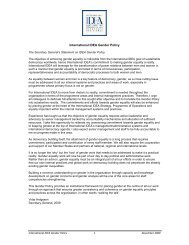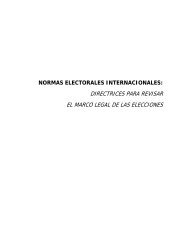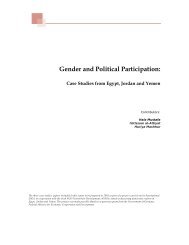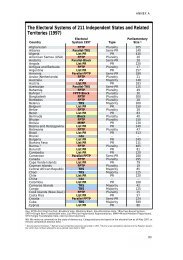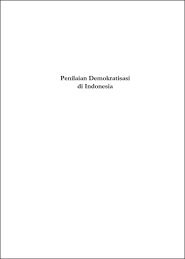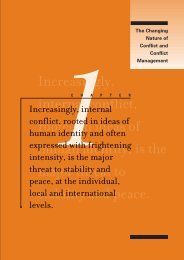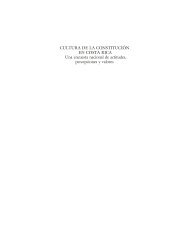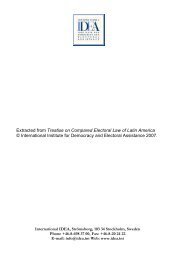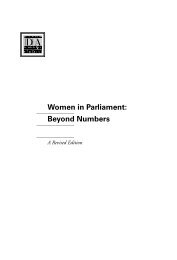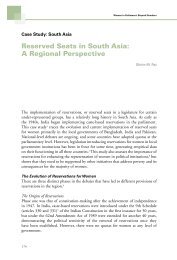The Role of State Constitutions in Protecting ... - International IDEA
The Role of State Constitutions in Protecting ... - International IDEA
The Role of State Constitutions in Protecting ... - International IDEA
You also want an ePaper? Increase the reach of your titles
YUMPU automatically turns print PDFs into web optimized ePapers that Google loves.
Indigenous people<br />
<strong>The</strong> Australian federal system has worked reasonably well to protect small <strong>State</strong><br />
communities from the larger <strong>State</strong>s, while still enjoy<strong>in</strong>g the advantages <strong>of</strong> union.<br />
All Australian <strong>Constitutions</strong>, however, both Commonwealth and <strong>State</strong>, were writtten<br />
for a monocultural society. At the beg<strong>in</strong>n<strong>in</strong>g <strong>of</strong> the 20th century, the<br />
Australians saw no need for their <strong>Constitutions</strong> to accommodate cultural diversity.<br />
<strong>The</strong>re is no protection <strong>of</strong> rights <strong>in</strong> either the Commonwealth or <strong>State</strong><br />
<strong>Constitutions</strong>, although the former precludes the establishment <strong>of</strong> any religion.<br />
One hundred years later, largely as a result <strong>of</strong> immigration, the Australian<br />
population is very diverse. Moreover, although there have been no relevant<br />
changes to the Commonwealth Constitution, the system has adapted to these<br />
new circumstances reasonably well, although without seriously challeng<strong>in</strong>g the<br />
dom<strong>in</strong>ant culture. New, multicultural policies have been adopted, through the<br />
ord<strong>in</strong>ary political processes, at both Commonwealth and <strong>State</strong> levels. Antidiscrim<strong>in</strong>ation<br />
legislation has been <strong>in</strong>troduced and works quite effectively. <strong>The</strong>re<br />
is relatively little <strong>in</strong>tercultural conflict. Whatever their backgrounds, all<br />
Australians are free, with<strong>in</strong> the private sphere, to pursue their own religion, to<br />
speak their own language and with<strong>in</strong> limits, to follow their own culture.<br />
<strong>The</strong> Australian constitutional system has worked much less well for <strong>in</strong>digenous<br />
Australians, however. <strong>The</strong> <strong>in</strong>digenous people are a small m<strong>in</strong>ority <strong>of</strong> the<br />
Australian population; <strong>in</strong> 2002 approximately 2 %. <strong>The</strong>y live <strong>in</strong> all <strong>State</strong>s,<br />
although with a larger concentration <strong>in</strong> the north, dilut<strong>in</strong>g their <strong>in</strong>fluence further<br />
still. <strong>The</strong>ir culture is unfamiliar. <strong>The</strong>y occupied the whole territory, at the time <strong>of</strong><br />
European settlement and <strong>in</strong> that sense represented a threat. Partly as a<br />
consequence, there is a direct conflict between their <strong>in</strong>terests and those <strong>of</strong> the<br />
majority community.<br />
At the time <strong>of</strong> European settlement, from 1788, Australia was deemed to be “terra<br />
nullius”. <strong>The</strong> <strong>in</strong>digenous legal system was ignored and, with it, <strong>in</strong>digenous<br />
<strong>in</strong>terests <strong>in</strong> land. <strong>The</strong> <strong>in</strong>digenous people were dispossessed by the settlers and<br />
pushed north and west. More than one hundred years later, at the time <strong>of</strong><br />
federation <strong>in</strong> 1901, the <strong>in</strong>digenous people were expressly excluded from<br />
Commonwealth power. <strong>The</strong>ir <strong>in</strong>terests and welfare thus rema<strong>in</strong>ed entirely with<br />
the <strong>State</strong>s. <strong>The</strong> <strong>State</strong> <strong>Constitutions</strong> conta<strong>in</strong>ed little, if anyth<strong>in</strong>g, to protect them.<br />
<strong>The</strong>re was no special provision for <strong>in</strong>digenous representation; <strong>in</strong>deed, they were<br />
not fully <strong>in</strong>cluded <strong>in</strong> the franchise until the 1960s.<br />
As a result, throughout most <strong>of</strong> the 20th century, the <strong>in</strong>digenous people <strong>of</strong><br />
Australia were treated very badly. Until relatively recently there was no<br />
recognition <strong>of</strong> their law and little <strong>of</strong> their culture. Many groups lost their<br />
languages. Except <strong>in</strong> the far north, they were generally without land. <strong>The</strong>y<br />
suffered extreme social and economic disadvantage. <strong>The</strong>y were politically<br />
powerless to remedy their own situation.<br />
40




